16 - 31 May 2003

| Germany 16 - 31 May 2003 |  |
Friday, May 16
Saturday, May 17
Arrival: two hours late and no sleep on the plane. I did, however, witness a full lunar eclipse off the starboard wing from 4:00am-5:00am German time! We land in a moderate mess having missed our scheduled train to Weimar, but all is well in the end and we lost no additional time at any rate.
Hotel check-in, then a short tour with Annette Krug and Joe translating. (Annette is one of the interns at the Thüringisches Landesamt für Denkmalpflege: i.e. the Thuringian State Office for Monument Protection). Not actually "pearls before swine" as Joe says... Group dinner in a nice, but rather empty, restaurant. Goulash was distinctly dull, but cucumber with dill sauce was a welcome introduction to German fare. Anna Amalia hotel is lovely, lovely: the third star (laundry service, terrific breakfast, elevator, and cable TV) is a nice addition to what Wade and I usually get in Europe!


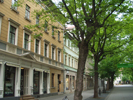
Rathaus Rathaus Square Schiller Strasse
Abbey of Volkenroda
The church there is a part of the oldest extant Cistercian monastery in Germany (it's the fourth one founded, but obviously, the first three are now gone). The decision was made among locals, preservation professionals, architects and others to restore the church building back to its Romanesque origins. Having said that, it was very much a local effort to clean up and rubble and stabilize the building, though the architect who renovated the Cologne Cathedral advised and consulted on the process.
The church was to have been leveled in 1989, but saved because of the German reunification (Die Wende they call it: the Turning Point). Before this time, the town had lost population and right after reunification their economy was suffering (it's a substantial agricultural economy in this area of Thüringia). After the renovation of the church and adjacent convent, the Christus Pavilion was added to the area. Built as part of EXPO 2000, it was designed specifically for the Abbey of Volkenroda and is an amazing and very effective modern complement to the area: truly, a twenty-first century sacred space. This highlights one of the successes of the Volkenroda preservation project, namely the co-existence of medieval and modern. The inside of the twelfth-century church contains a stylized, modern crucifix, while the convent itself is a glass building surrounding and abutting the bits of ancient and original wall still standing.
Wartburg Castle
Here we get the standard tourist tour of the castle where Luther spent some time translating the Latin bible into vernacular German. Perhaps had we seen a preservation specialist we would have a better idea about the actual preservation ethics of this site. As it was, it seems evident that the site has been "redone" several times: the capitals were recarved on interior columns in the 1980s; paintings were added to the interiors to simulate medieval decorations and tapestries in the 19th century.
Now, of course, these 100-year-old paintings can also be considered historic – hence another common preservation debate on what should or shouldn't be saved and preserved. In fact, their painting restoration in one of the rooms appears to be merely a rubbing off of dirt – and paint – and then a repainting of the figures! What is perhaps most interesting to me is that knowledge that Luther was "rehabilitated" by the GDR in their later years as a "model German" revolutionary against the capitalist establishment of the Catholic Church (perhaps this is why a renovation effort here at Wartburg took place in the 1980s before Die Wende). Plaques near Luther's room tell of "the economic radical upheaval of the times..." and describe how "the salvation of one's soul was... not a commodity to be bought."
Goethe is also a figure related to Wartburg as he thought the site was important to German history and should be preserved for public visitors. A plaque in one of the rooms quotes an 1815 document that said they had "plans to equip the architectural monument in the style of a museum in the hope that the fortress would be able to count more pilgrims." So, heritage tourism is not a 20th-century invention!
Open Museum Night in Weimar!
First, a restaurant dinner – insisted upon by colleagues who speak no German and are afraid to eat "street brats" – sigh... Not a fabulous meal, but Jim and Scott provide good conversation. After that, a trip to the Geld Automat (ATM) to replenish the stock. Saw a 30-minute organ concert at the Jakobskirche (where Goethe was married). After that a long wait to see the disappointing WitumPalais (Anna Amalia's "Widow's Palace"). Rather horrific and amateur marbleizing effect in the FestHalle. Restorations, again, done in the 1980s. Were GDR officials lacking in preservation experience? in money? in giving a damn about anything "authentic"? Finally a splurge of ice cream at the Eiscafe & Bistro, billed as an Italian gelaterie. Back to hotel by 10:45p to read a book before falling asleep around midnight. Much revelry outside, but a great bed and Katy is a quiet and accommodating roommate.
Sunday, May 18
Up early at 6:30a to eat a great breakfast – truly continental – of cold meat, cheese, salmon, cucumbers, tomatoes, and a pot of Earl Gray.
A fabulous tour led by a pedagogical expert – Frau Pia Frohwein. The camp was also an SS training camp, apparently a common practice to have these next to German concentration camps. In fact, there were 16 SS barracks at Buchenwald. This brings up an interesting point in how to deal with the perpetrators: should one restore the SS barracks? And if so, how does one keep from glorifying or honoring the SS in doing so? If not, then how does one deal with how this horror happened?
Those SS barracks that have been restored here house the International Youth Center, among other things, because these students cannot be housed in the symbolic graveyard which is the camp itself. One must also be concerned about the neo-Nazis coming here to honor either the SS or the Nazi "victims" of the post-World War II Soviet Camp #2. Pia spoke of the problems in presenting these mass graves of German prisoners; in this case, Buchenwald has decided to keep a simple, minimalist presentation at all the sites to keep from emotionally memorializing the site.
Again, this highlights the politicization of the victim v. perpetrator issue in German memory sites. This is a different tack from previous times: the red rose garden once outside the restored SS barracks was apparently a common Soviet/GDR memorial. Pia said she found this not only inappropriate, but "irritating". Since 1993, restoration has been ongoing with the ruins of SS residences outside the camp. Again, this is to include the SS as part of the interpretation of perpetrators. In this case, one presents the SS as "normal people who were radicalized somehow into participating in this horror. Details about how a mass organization functions and its associated corruption, bribery, heavy drinking, and mandatory behaviors are important here. This is a gray portrayal of history, as opposed to previous black and white attempts that portrayed the SS as inhuman animals and the other Germans as anti-fascist heroes. (She stresses the high suicide rate among the Death's Head squads of the SS – is this because they have realized their failure to conform to the brutality, she wonders?)
Another attempt to show the everyday life of the SS was the restoration of the zoo right near the camp gates. Again, this points to the notion that all human beings can "disconnect what doesn't fit". The SS and their families can deny the camp's gruesome existence while "playing" and looking at the animals. Perhaps they truly believed that the inmates were subhuman enemies of the state. These portrayals of the SS as human beings radicalized into murderous behavior, as opposed to inhuman monsters, means this lesson must be learned by all humans. If it can happen here, can it happen anywhere and to anyone?
Pia made additional comments and questions about the ongoing victim v. perpetrator, innocence v. guilt debates in these memorial sites, namely: 1) who defines postwar guilt in a dictatorship? how many citizens are actually responsible for a state governed by just one man? 2) what do you do with low-level Nazis after the war? whom do you judge and where do you draw the line? 3) what do you do with a people whose governmental policy was genocide? These questions were integral to the de-Nazification process undertaken by both the Allies and the Soviet Union. Decisions were made at every step, though they were neither easy nor self-evident at the time. Hindsight being 20/20 makes us think differently about their decisions sixty years ago.
In addition, great numbers of the German populace participated in this genocidal system, though it's possible they didn't know the extent of the murder and torture. Pia says this revolved around the question of "who is 'us' and who isn't". She said 60%-80% of the prisoners were sent here because of informers among the "normal" German population. The main gate says "Jedem das seine" (to each his own). This is a cynical twisting of a positive statement that can mean "you get what you deserve."
Between sixty and seventy Weimar city companies were involved in the running of the camp (providing materials, doing paperwork, etc.). The camp "was not on another planet"; indeed, there was forced labor in about 100 Weimar city companies and, of course, the population saw them on a regular basis. Certainly resisting against Nazi power and specifically the Buchenwald camp was difficult because of the Nazi terror itself, Pia says that nobody was forcing these companies to used forced labor to supply the camp. This, then, must spread the guilt – or at least the responsibility – throughout the larger surrounding population.
The Buchenwald Bahnhof (train station) ruins have been cleaned off and "restored" only after reunification. Pia says this is because of its symbolism as transport not only to Buchenwald but away from Buchenwald to the extermination and labor camps further east (Auschwitz, etc.) She reiterates the recent historiography on the subject, saying "without the thousands of workers on the German railway, this system of camps wouldn't have worked." And again, "normal people were involved" in this system – something Pia says they stress in the educational programs at the camp.
Pia said they have made a choice not to restore the ruins of the forced-labor factories, as this is not the "main thing" they're dealing with in the camp. Perhaps this is a reaction against GDR times when the economics of the camp and the country were emphasized, perhaps to the detriment of dealing with the racial and ethnic issues surrounding the genocide. Buchenwald follows strict, international guidelines (like the Venice Charter) when she says they choose to "just excavate, not orchestrate" their sites. They don't reconstruct or add things. Indeed, the visitor must do "his own work" to imagine what the camp looked like sixty years ago. It is the museum that tells the stories that the remnants of sites cannot.
The new memorials at the site contain only photographs and minimal captions, without explanations or attached emotions. In the same vein, they are careful not to recreate pieces by making them look old or original: the barbed wire and concrete fence have been repaired in a small section, with the modern repairs obvious to any eye.
The Buchenwald camp was one of the first concentration camps to be opened as a memorial. In part it opened in 1953 and was opened at large in 1958 in great part as a GDR memorial to anti-Fascism. This outlook informed many of the preservation decisions. The crematorium was preserved only because Ernst Thalman was shot there; the prisoner barracks weren't preserved because they simply didn't have a bearing on the anti-Fascist revolt in the camp. In fact, Pia said the GDR didn't want to emphasize the fights between prisoners and the hierarchy among prisoners in the camp as it placed too much emphasis on social hierarchy and classes of prisoners. The GDR's "leveling" of classes among people was symbolized in the leveling of the prisoners' barracks. At the same time that they're leveling parts of the authentic memorial, they're building their bell tower memorial outside the camp (Pia calls this a "symbolic contradiction").
The Kleines Lager (Small Camp that was the quarantine camp within a camp) is a recent restoration, again not important to the GDR except that the latrine as a meeting place for the small band of Communist resistors. Also created is a "negative monument" on the place of the wooden obelisk where prisoners held their first commemorative service just days after the liberation. This new site doesn't recreate the obelisk, but is a minimalist, non-interpretative monument containing a heat source underneath the ground (as opposed to the above-ground eternal flames) that keeps the monument at human body temperature (98.6 deg F). It is both a symbolic graveyard and a kinetic site that requires human movement to reach down and touch the monument.
The memory landscape at Buchenwald is complex: it comprises both GDR monuments and post-reunification monuments. Each in their own way seek to affect memory and its place in the present and future. The Buchenwald education programs that Pia runs also seek to open up this landscape, but she asks: "what effect does all this education have if the family stories [of the German people] all say that they were bomb victims and anti-Fascist martyrs?"
Part of the newer generation's response to these family stories was to become "barefoot historians" and participate in the "dig where you stand" movements in the 1970s. One of their mottos was "don't trust a pile of rubble"; in other words, something must have been destroyed to hide something. The uncovering of concentration camp histories in Germany was part of this grassroots movement as well.
On the other hand, Buchenwald survives in its entirety because of the GDR heritage of memorializing the anti-Fascist heroes, so perhaps one must be grateful for that. A obviously GDR-era caption at Block 17 reads "In honor of the memory of the members of the British and Canadian forces murdered in Buchenwald concentration camp. The lives of four British patriots were saved by the solidarity of German anti-Fascists." A photographic and art exhibit with captions in German, English, and Russian display mostly post-war memorializations of the camp in a building just behind the Goethe Oak (i.e. Stump).
In the photographic exhibit (Black & White), they describe the contemporary taking of pictures at the time of liberation as a "way of believing the unbelievable". The photographers, both professionals and amateur soldiers, have in common the "struggle for a view that does not distort Buchenwald, but makes it visible." The contemporary art exhibits are in stark contrast to GDR-era plaques. One reads that the exhibit is "conceived as a permanent approach and confrontation, not as interpretation..." In another section, a caption describes the "survivors' need to describe and communicate led them to revert to the codes of the camp world [in their art]' ... barbed wire, watchtower, the main entrance gate, the smoking chimneys..., emaciated figures, the roll call, piles of corpses..." The art is most often by non-survivors who keep alive the memory "not to illustrate but to keep the wounds open", to "present clichés of past realities", and to "reflect the events of the present against the negative yardstick of the past."
Pia mentions the perhaps over-strong emphasis on Jewish victims in the U.S. media. Interesting point, but perhaps globally this balances out the complete denial of Jewish victims as a separate group in places like Auschwitz. Certainly the creation of memory is a complex business, especially here...
The "new Buchenwald interpretation" also concerns the loss of GDR identity. They glorified the anti-fascist Communist heroes, but didn't memorialize the conservative, right-wing conspirators of 20 July 1944. Joe describes this as a key memorial site for GDR identity. Is this so? Is it because it's so close to Weimar? The contradictions between Weimar and Buchenwald are stunning and are a microcosm, perhaps, of the larger contradictions within pre-war Germany. 1) Associationalist architecture: Weimar classical architecture = enlightenment; völkish architecture = Heimat and Nazism. 2) Weimar constitution is associated with the "poets and thinkers" of classical Weimar; the first elected Nazi officials in Germany are in Weimar 3) Weimar enlightenment concentrates on the individual; Fascists/GDR consider the collective good Weimar is really important as the sum of its parts, rather than its individual pieces. It had a better status among GDR towns and warranted more restoration efforts, etc. There is also an uncommon focus in Weimar with Buchenwald so close to the town of Goethe and Schiller. This reminds us that education is no automatic protection against horrible acts. Pia says we must, as citizens, continually ask ourselves: "what do we want if not this?"
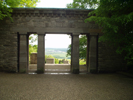
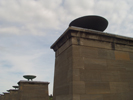
Soviet Memorial at Buchenwald We returned via bus and stopped at the Weimar Bahnhof to walk through the Nazi Gau Forum on the way back. Once a field (parade ground? assembly space?) surrounded on three sides by Nazi-style governmental buildings, the GDR placed a fourth building on the fourth side. Then to another Thüringian-style restaurant with all ten people; we all get something other than what we ordered!
Monday, May 19
Erfurt
We meet with staff members of the Thüringisches Landesamt für Denkmalpflege. Their predecessor was founded in 1963; this iteration begun in 1990. The office provides technical and scientific assistance to the Thüringian state, as well as deciding who gets on the Denkmal list. The staff have advanced degrees in architecture, engineering, art history, etc. Monument protection is first and foremost the responsibility of the property owner, as stated in the various articles we read on German preservation organizations and philosophy. Currently there are 35,000 monuments on the Thüringian list!
A walking tour of Erfurt follows. We enter a 13th-century room that remains the same because it had been used as a storeroom for the last 700 years until 1990! From there we look at the conservation of wall frescoes in the Benedict Kirche. Great technical expertise abounds here, yet they still want to repaint the 14th-century art! Is this the national climate here in Germany or just something leftover from the GDR days? Is it because so much was destroyed in World War II an subsequently rebuilt? Have they thus lost their sensitivity to wide-scale reconstructions?
The St. Mary Dom is a beauty and their head of restoration conducts a wonderful tour with the help of his American-fluent niece (she had gone to a high school exchange program in Oklahoma three years ago.) In the stained glass restoration workshop we finally see more of the international preservation ethic: they're very careful about full-scale repainting, though they must do some of it just to keep the pieces viewable. There's a beautiful altar piece hidden from the public while restoration takes place on stabilizing the walls with the latest technology and mortar infill. These dratted towers have fallen in quite a few times, so perhaps this will be the final fix!
Rain, rain, rain again. I ditch the herd and take the train home alone. Very happy to have dinner in the room alone, sleep alone, hear only my voice for just a few hours...
Tuesday, May 20
Goethehaus
A wonderful tour for tourists and not preservation professionals, but it's still good to see how a place is actually presented... and she truly was a wonderful tour guide. From the looks on the faces of the bored others in the group it appears there were only a few people who were actually interested in Goethe. One compared him to Jefferson who also "collected a lot of crap." So be it. She mentioned that the house treasures were moved to a mine for safekeeping during World War II and hence were saved. The Goethe private apartments had to be reconstructed, however, after a direct bomb hit. In addition, walls and paintings have been touched up over the years as they're all in great shape now. Perhaps much of this work was also done in preparation for Weimar's year as Europe's Cultural Capital in 1999. An interesting confluence here is that Goethe himself collected copies of masterpieces and now his house is a copy of itself!
Ulmpark
Weimar in the 1600s could be called not a city within a park, but a park that just happens to have a city in it: so says our guide Dr. Martin Baumann, a landscape architect with the Landesamt. The rain begins now in earnest: those with forethought don ponchos or take out umbrellas, the rest huddle damply under a tree and repeat their litany: "I don't like the food... the weather... the tour..." The park is a studiously picturesque landscape with created ruins, the Goethe Gartenhaus, a bomb-ruined Gothic chapel, and a herd of sheep complete with shepherd and dog. The park is run by the Weimar Classical Stiftung (Foundation) as are a number of other parks in the area. Next a wonderful lunch sitting at the table with Dr. Baumann talking about American movies... and a bit about landscapes.
Bauhaus University
The tour begins outside the famous, original building and then moves inside. (The "Bauhaus and its Sites in Weimar and Dessau" is listing on the World Heritage list.) Like other places, they've had to repaint pieces of the interior. Here, they've redone a copy of a stairwell painting then scuffed it up to make it look nice and old! To quote our tour guide, "the doubtful preservation techniques [restoring by copying and photos] actually results in a great pedagogical experience for visitors."
Now a visit to Gropius' office, which was fascinating. Once we enter the preservation offices, we receive a very impressive presentation of their student projects and the work of the faculty themselves. Better than our Historic Structure Reports, these projects combine high-quality computer work and drawings with detailed analyses and recommendations for conservation or restoration of sites not only in Germany, but other countries. Following international principles, they said one should not re-create unless one has documentation and one doesn't make the old look like the new (so, what about those dratted stairwell paintings?)
My case study and bibliography of historic preservation in Thüringia: the GoetheHaus, Wartburg Castle, and Buchenwald Concentration Camp.
Wednesday, May 21
A lovely early morning walking about the town the last time; purchased small amounts of small souvenirs and took final pictures. Spent 30 minutes on the Theater Square next to several pre-teens who were smoking cigarettes, drinking beer, and yelling at the school groups taking their pictures in front of the Goethe and Schiller statues. Finally in to the Bauhaus Museum at 10:00am.
We travel to Berlin via train; thankfully, it was uneventful. In the evening, dinner is at an okay Indian restaurant where we sit outdoors at picnic tables watching a large projection of various Absolut signs on the blank building wall. From there to an artist colony in an old hell of a department store across the street. Once squatters, the artists are not legally there by city decree. So, if Weimar is a Disneyland, so is this place: a purposefully maintained caricature of East Berlin artists from days gone by.
Thursday, May 22
The "Berlin Palimpsest" is today's theme as we take a walking tour up Unter den Linden and through the major sites of the city. Medieval Berlin, now mostly gone, was in the areas now occupied by Museum Island and the Alexanderplatz; Classical Berlin is represented by Humboldt University and its complex of buildings; Nationalist Berlin, beginning with 1870, is present in the statues, the Berliner Dom, and other sites; Weimar Germany is visible in sites associate with socialist uprisings in the 1920s; and finally the GDR sites have the now-vacant and increasingly decrepit Palace of the Republic. The Tiergarten beyond the Brandenburg Gate was a hunting ground first. Then Frederick the Great donated it to the people of Berlin in 1742, representing one of the first public parks in Europe or the U.S. At this time the "Baroque geometry" of the garden is layered over the older topography. Beginning in 1833, the marshes are drained, canals created, and the Zoo is established.
Märkisches Museum
A "model of museum reform" for its time, it was built in 1908 to house its collection of historical Berlin artifacts. The exterior is actually a museum of styles, done on purpose to "describe" regional architecture from Gothic forward. In the 19th century, museums were built to house complete collections and did not consider room for expansion. Thus, this building faces a modern problem as it now has expanding collections that are housed in a museum that was specifically designed for its specific collections. In other words, how does one create an exhibit on the Berlin Wall in this space that was built in an historicist manner?
Their photographic collection was created in the late 1800s as curators realized they needed to document the buildings that were being torn down so rapidly. (An interesting junction here is that's exactly what the Warsaw builders, architects, and students were doing as they realized the fate of their city at the end of World War II.)
The war caused damage here as well. The walls in the central hall were rebuilt and completed in 2000 with the same plaster and techniques used on the original wall (they used documentation from the previous time to accomplish this). There was apparently a discussion at the time about possibly deviating from the Gothic style in this hall since the architecture of the museum has such an impact on the exhibits and how they're viewed. They decided, however, to keep the historicist atmosphere, but make it obvious that this was a restoration, not an original space. This museum was really the last in a line of historicist museums. It was designed by Hoffman, a museum reformer, who built it in opposition to Victorian-era museums that held cluttered arrays of hundreds of objects in each room. After this museum, however, rooms were no longer designed to be in keeping with the theme or time period of the exhibits.
The "Guild Room" is all done in wood with a paneled ceiling, creating the atmosphere of the time whose objects are present. This means the museum is not really displaying its artifacts for academic research purposes, but for the more unlettered public. From this room one enters the "Industrialization Room" decorated with a different theme. Interesting here is that nothing is said about the workers in industry, just the owners and the businesses themselves. Dr. Sven Kuron says this will change next year to represent a broader view of labor history.
Next the "Gothic Chapel" holds the liturgical and religious objects. From there to the room holding photographs of what had been the Schloss (Royal Palace) on Unter den Linden. An interesting mesh of politics and museum management as this room got a lot of press when it reopened in 2001 – all because of the current debate on the possible rebuilding of the Schloss and the demolition of the GDR-era Palace of the Republic. Prehistory was one of the museum's largest collections. As its founder, Ernst Friedel, said in a quote on the wall: "it was mainly by looking back on the ancient history of the Mark Brandenburg that local identity was construed."
Another interesting juxtaposition is between this museum and the new Jewish Museum. Both were built for an existing collection; both have architecture that plays a large role in the design and display of the exhibits. What is obvious in these museum tours is how hard Germans are now trying to include all of their history, the good and the bad, in these public places. The inscription on the Neue Wache was a very carefully worded commemoration of just that. Without mentioning any specific groups by name, they include all those who "by their actions" (and not by belonging to a group) were to be remembered.
Friday, May 23
Landesdenkmalamt Berlin
Rain again! We begin with a presentation by Dr. Christine Wolf and others in Berlin's preservation offices in the beautiful new City Hall – like so many others, recently restored. (Their old offices had been in the Rote Rathaus, but it had become too small.) This building was also designed by Hoffman (who did the Märkisches Museum) Berlin is now divided into twelve districts (it had been 23). This office is part of Berlin's office of town planning, but they still have only restricted influence in new building design. They also raise money by means of lotteries and private donations. The Day of Open Monuments is quite a big deal both in Germany and across Europe.
Like other preservation organizations, these professionals understand the philosophy that all historic changes should be preserved and not everything must be restored back to its original look. Here, they say the "intelligent eye" can read the GDR history in the building (Ruskin!). For instance, the holes are still in the walls were the ceiling was put in by GDR officials. They also realize that compromise is necessary between commercial and preservation interests, especially with Berlin's economy in a downward spiral. Their "main instrument" for preservation are the tax incentives given to owners who actually use their monuments. These are 10% for 10 years and as there is no comparable tax reduction for new buildings, this is a great incentive to restore and reuse monuments. The office is also concerned about protecting Nazi-era monuments, though they understand the delicacy inherent in this. They said it would have been "ridiculous" to protect the Berlin Wall at the time it was being dismantled, though they do regret so much of its material loss. Imagine, they said, preservation professionals standing in front of the growing and emotional crowds saying, "No, don't tear down the Wall!"
Neues Museum
An historicist museum built in the mid-1800s (hence, it's the "New" Museum!). It hasn't been open since it was damaged in World War II, but will reopen in 2006. An architectural contest was held to determine who would have the contract to rebuilt. The winner will certainly preserve the structure and restore its original massing, but the new construction will be obvious.
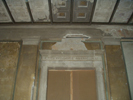
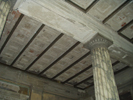
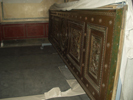

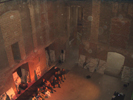
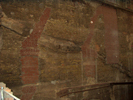


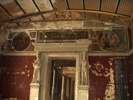
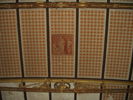
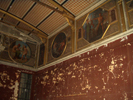
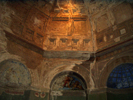




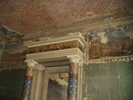

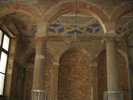





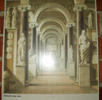

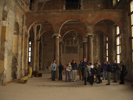
My paper and bibliography on The Neues Museum and Berlin's Museum Island: A Representation of German History
Finance Ministry (Nazi Air Ministry Building)This building holds both Nazi and GDR layers and is now in use by Germany's democratic government. As our guide says, this underscores that democracy is stronger than totalitarianism: it can actually "change" a building into something else. Lights are now added where entrances would have been dark in Goering's era. Greenery has also been added to what had been only a concrete/stone inner courtyard. These point up another example of associationalist architecture as one seeks to portray a reality or an ideal by using design and architecture. At one point, our guide indulges in a conspiracy theory. Since the building wasn't destroyed by American "precision" bombing (good heavens!), he believes it was because they 1) wanted to terrorize the population and the building was doing that just fine, so leave it up! ; and 2) there was an American-owned power station across the street and obviously we wouldn't want to bomb our own stuff! An interesting anti-American stance from a West Berlin native...
After this day, Scott and I go to a KammerMusik concert in the Berliner Dom. We hear a wonderful KnabenChor (Boy's Choir) and a small instrumental ensemble. Dinner and wine at the Hackescher Markt on the way home, with scoops of ice cream for dessert.


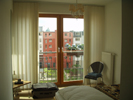
Hotel apartment in Berlin Mitte
Saturday, May 24
Toured the Tiergarten in depth with the landscape architects on the trip! Nice and relaxing – no standing, just walking. Sadly a blister develops anyway. Lunch in a quite expensive place at Potsdamer Platz. Looked through new buildings, then back to hotel to change into better walking shoes. Napped instead of leaving, until Katy and decided we needed to race down to the Pergamon Museum for a quick look of the large architectural displays.
Sunday, May 25
Since I couldn't manage to get into the Berliner Dom any other way, I went to their 10:00am church service and sat in Loge J where the English translation was being done. As expected, their Lutheran liturgy is identical to the one I grew up using and the first hymn was one of Grandma Helen's favorites! After this a l-o-n-g stroll up Unter den Linden again and into the Berlin Story bookshop for three more books on Berlin. Through the Sunday street fair and on to the S-Bahn to check-out KaDeWe – closed as I suspected.
The Wittenberg Platz Bahnhof was a beautiful old station with a sign out front listing all the concentration camp destinations the trains took the people herded onto the sidings here in this quite lovely section of Berlin. The contrast boggles the mind as one tries to imagine what it would have been like. This small remembrance reminds me of the shiny brass cobblestones now in front of buildings in Berlin-Mitte (an old Jewish section). Each has the name, death date, and concentration camp destination for each person who lived at that location before being deported during World War II. These appear quite new and that would conform to what one reads about the GDR not being as interested in memorializing Jews as a specific group.
A trip out to the Olympic Stadium yields nothing as only group tours are allowed. To La Bohéme in the evening at the StaatOper on Unter den Linden. A 19th century opera house with four balconies all having good and close access to the stage.
Monday, May 26
Treptower Memorial
A great tour with Dr. Nikolaus Bernau. He begins by saying one "can't ever have a reform movement [in Berlin] without it being stopped in the middle." Calling this the "central problem of Berlin" in terms of city planning, he bemoans the lack of a grand plan a la Paris. We stop at the intersection of Rosa Luxemberg Platz and Menhardstrasse where he shows us four layers of reform and rebuilding! He reminds us that unlike "well planned" European cities (Copenhagen, Venice, Paris, etc.) Berlin uses the space once taken by its old Baroque city wall not to build green space or canals, but rather to put up railroad tracks! Hence, the comparison rings true: Berlin is the Chicago of Europe. Other interesting layers in the cities are the railroads themselves. Some were state-owned and some were private-owned; this made for interesting connections, if they existed at all!
We stop at the Treptower Memorial for the USSR soldiers. Unlike the Buchenwald and other memorials, this one is not for anti-Fascists and GDR citizens, but only for the memory of the Soviet soldiers. The construction and layout of the memorial is similar to Buchenwald's in that there are carved blocks of figures that "instruct" you as you walk through the site up to the large statue. Marble blocks from the old Reichs Chancellery were used to build these structures... or so the story goes. It's possible they came from the huge storehouses of stone that were stockpiled for Hitler's building of the new Germania (that would replace the city of Berlin). The eternal flame at the site has a plaque which reads: "the eternal flame for the heroes who fell for the freedom and independence of the socialist Heimat." All Soviet memorials in Germany have been protected since the reunification.
Oberschöneweide
As we continue the tour, Nikolaus mentions the confluence of architecture and politics. As in the readings he mentions the choices people and developers made about their residences: flat roofs = liberal; steeply-pitched völkische roofs = conservative. We now find ourselves discussing the history of the AEG company and it's second location in this area (the southern Berlin facility for the electrical industry).
Nikolaus reminds all that Berlin is the only world capital built on industry, not on support of the government bureaucracy. With regards to the electrical industry, architecture is a marketing tool. The gas industry, more established and conservative, was not a player in modern architecture. However, the electrical industry sought to align itself with modernism, hence its factory buildings are modern! This is an industrially-planned district and so it was conceived with cost-savings in mind, even though well-known architects participated in its creation. Perhaps this is more "architectural name dropping" to associate AEG with these artists.
Nikolaus said the district had the "good luck and bad fate" to be in the GDR: there simply was not enough money to tear it down (unlike the districts in Wedding where the original and more famous AEG Turbine building is). There were 30,000 people working in the district before reunification, now there are only 500 workers left. It all happened so fast that there was no time to remodel the buildings and hence, the historic district has been saved. The buildings are now under protection, but while Nikolaus says the law is "strong", the political and economic climate of the times is saying, "tear it down!"
Prenzlauerberg
This is a high-density commercial and residential area of Berlin built just after the Franco-Prussian War (1870-1). Sabine Schilf of STERN gives us the tour of the area. STERN is an organization that manages the urban renewal projects in the area. They provide advice and consultation, but don't actually own any of the property. As opposed to a preservation-centered organization, they are more interested in the uses and revitalization of existing properties. When asked about the effect of gentrification on this area, Sabine answered that it is perhaps not a matter of higher rents that have forced people to move. Rather, the social and cultural change of the area has perhaps made them move elsewhere. She said that those who want to stay here can stay: they have rights and abilities to get serious rent subsidies from the government to remain. They can't refuse to renovate, but their rent increase is very gradual and "gentle". She said that part of STERN's work is to make this inevitable gentrification a more people-friendly process.
Tuesday, May 27
Hansaviertel
We begin back at the Tiergarten to look at West Berlin's architectural response to Stalinallee. Well-known architects designed these buildings to express the new world view of West Berlin: their 'erasure' of history and separation from the Nazi past. If society's goal at that point was to have all classes be equal, then the socialist collective represents this goal in the East, while individual consumerism represents this in the West. The "ethos" of the Hansaviertel is part of this consumerism outlook. In general, traditionalist architects were more compromised after World War II as they were associated with the neo-Classical Nazi architecture. The Hansaviertel had contained 19th-century building stock that probably could have been saved, but the decision was made to make this a "new suburb" after the war and part of a new "ribbon city". Screwed up lunch time with the Biergarten not really open when it was supposed to be, so I do the dumb thing and follow a crowd on a mile hike up to a bakery near the Zoo. Unpleasant and whiney company on this occasion.
Stalinallee
Here again the associationalism is clear: architecture will create the model socialist citizen.
Prenzlauerberg
Why back again? Nonetheless, the tour is moderately interesting of the Kulturbrauerei and the Altwasserturm (Old Water Tower). This tour guide has a few choice words to say about STERN: an organization that she says is more concerned with tearing down an old building to create open green space.
Wednesday, May 28
Jewish Cemetery
Opened in 1827, this cemetery on Schönhauser Allee is a good stop. Some stones are knocked over, but most are standing and in good shape. Most of the death dates in the cemetery are from the 1870s to the 1910s. As Frank Rosenbaum would say: these are The Lucky Ones. One can see that metal has been removed from many of them (was this done during World War II or afterwards?) Some stones have death dates of 1939 or even 1943: how is this possible? Were there actual Jewish burials taking place during World War II? Were these brought here after the war? An inscription in the area reveals that the cemetery's restoration was completed in 2001 with a gift from the Deutsche Bank. It would be interesting to know how much the GDR did in the area.





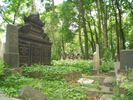
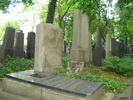
Jewish Museum
Architecture and memory are intersecting in this place that attempts to depict two thousand years of Jewish history in Germany. The location had been that of the West Berlin city museum (before the two halves merged into the Märkisches Museum). The museum is now run by the German federal government and no longer by the city of Berlin. It had only a small Jewish section at the time and once the city exhibits moved, there was space enough to house all the Jewish exhibits. Like Hoffman's Märkisches Museum, the architecture often overwhelms the exhibits in this building. Most visits are non-Jewish Germans who only have the idea that Jews are victims.
One of the goals of this museum is to show a broader view of Jews as "normal" people involved in the activities of everyday or even exceptional German life. This is why there are no exhibits of piles of hair, piles of glasses, etc. These present the Jews as not particularly human, the guide says. Their way is more non-confrontational with family history exhibits of the Jews making them look like anyone else. There are smiling, young, multilingual "hosts" scattered throughout the museum. The reason for this, the guide says, is that the building is so disconcerting and disorienting without these human touches.
The museum, like the Märkisches Museum, deals with history on a non-academic level. Hence there are few texts, but many multimedia presentations for the audience ranging from 8 years old to 80 years old. They are, she says, aware that they're playing with emotions here, but don't want to step over the line into "corny". Hence, they conducted multiple surveys of patrons and interviews with focus groups while designing the exhibits. As our guide says, "the architecture speaks for itself".
There is an initial "Dante's Staircase" that leads one down into the building, then a "Jacob's Ladder" that goes back up. One cannot enter the Liebeskind-designed building without going first through the original Baroque-style building. This signifies, she says, the Enlightenment period that finally got Jewish citizens equality in Germany (even though it took 200 years until 1918 to actually accomplish this!) The empty space signifies the complete loss of history and the reminder that there is this loss in the European Jewish experience. One couldn't, the Director says, integrate the Holocaust Memorial inside the building itself because it is a singular event that "stands outside" history itself.
The Garden of Exile is a place where the visitor can't get "rooted": the ground is tilted, the cobblestones are purposefully difficult. The willow oaks in the top of the concrete pillars don't root into the ground, but are just held in a pile of dirt at the top. One can also see the Holocaust Tower from the garden, signifying the guilt the exiles feel: "Why did we survive and they didn't?" So it's also a Garden of Guilt here. The Fallen Leaves exhibit is an oddly-shaped room filled with individually made "faces" of steel. Visitors are encouraged to walk on these, but this seems an uncomfortable action. Frankly, it reminds me of the pile of hair exhibits: it looks like a pile of Jewish skulls.
Our guide also points out the irony that these official Jewish memorial sites take visitors away from the actual sites where the genocide happened: concentration camps, etc. The Monument to the Murdered Jews of Europe is another such site that is invented by the German government as a political place. In fact, the Jews say they don't want the memorial and are often accused of taking precedence over other victim groups because of it. She says they don't need the monuments because they "live with the memories every day." So, what is worse, our guide asks: anti-Semitism (being beaten to death) or being cuddled (coddled?) to death?
The Director of the Museum meets with us next. A non-Jewish New Zealander, he speaks willingly of heretofore taboo issues in the memorializations of Jewish victims. He said the exhibits actually "muted" the emotional response that initial visitors had to the empty building! He said there has never really been a happy marriage between the architecture and the exhibition. The "axis" in the space is actually "art upon art", he says, as the experience is actually communicated better by the architecture in that space than other exhibits. In addition, the historians wanted to make an argument and "prove it" with the exhibits, but this is in tension with what he believes the audience needs. He actually thinks the entire exhibit could be both more efficient and more engaging. The task of the museum, he says, is simply to make people think further about the subject, not to tell them exactly what to think. Here, they had the challenging of "refreshing" a subject that most non-Jewish Germans said they knew enough about already. The result of all this vision is that the museum doesn't whitewash everything and so the non-Jewish Germans are both challenged, yet comfortable with the experience. The museum is determined not to become a Holocaust museum. They want to focus on "life, not just death". They don't want to hide it, just not to focus on it. The overall attitude of the museum, he says, is to allow all Germans to look at their past, not just Jews. He wants them to learn what it is to be Jewish and the historical interaction between two peoples.
Memorial to the Murdered Jews of Europe
Our guide is Dr. Günter Schlusche the Project Coordinator. He says it is crucial to understand that this monument is a memorial paid for and built by non-Jewish Germans: fully financed by the federal government of Germany because of a Bundestag decision to build it. Now the intersection returns to architecture and politics. There was a fifteen-year discussion about this project, beginning in 1988 before the fall of the Berlin Wall. It has been controversial among historians an the public, but includes a fundamental discussion on how to deal with the past. The intersection now moves to architecture and memory again. This site will be linked to the places that surround it (the Reichstag symbolizes the German government; the banks that symbolize the German economy; the Tiergarten; and the Pariser Platz with its four embassies of the Four Allied Powers). There is no hierarchy in this exhibit of stellae of multiple heights. There is also no central entrance or exit: "one must find one's own way". The information center will provide personal information for victims and additional information on the actual sites to visit (camps, ghettoes, etc.). He makes the connection between the other official sites of Jewish memory: the Topography of Terror and the Jewish Museum. This site will tell people to go to these other sites for information and research as there will only be the most basic information at this site.
What's interesting here is the choice of victim. The guide says that the Sinti/Romi ("gypsies") wanted their own memorial and didn't want to be overwhelmed by being included in this Jewish memorial. Perhaps it is just as easy to build sites for specific victim groups; at least this way, you don't let all Germans treat themselves as victims and not bear any responsibility as perpetrators. This differs than from Buchenwald where all Germans could see themselves as anti-Fascist resistors and bomb victims...
Now a group picture by the Brandenburg Tor, then run away to have a quiet dinner in the apartment, talk to Wade, drink a bottle of wine, and fall asleep at 10:00pm. Glorious!
Thursday, May 29
Topography of Terror
We get the regular English-speaking tourist tour here and not something specifically for preservationists. It is, however, always interesting to hear what would be said in a "normal" situation, so all is fine. She continues to make the point most important for her: that many participated in the terror. The uniformed police were integral members of the SS organization. Because the police didn't have to be SS members and the majority chose not to, they were given a clean slate during the de-Nazification process following the war. So, even though they did SS-type work, they got a pass! She also makes the point (that we've heard previously at Buchenwald) that widespread denunciations from within the German populace were what kept the Gestapo going. Again, she emphasizes the widespread responsibility and knowledge of the German population during the Nazi period.
Apparently there was an exhibit on the Crimes of the Wehrmacht in 2001 that caused a great outcry; before this, Germans could be confident in saying that the regular Army didn't participate in atrocities, only those horrible Nazis. She moves from here to discuss the "armchair killers" of the government bureaucracy. She talks about the inherent unfairness of deciding who's going to be punished after the war, who's going to get out early, and who's going to get away with it entirely! Returning to the widespread knowledge of atrocities, she mentions that the deportations to the camps took place in city Bahnhofs in broad daylight. In addition, the camps are quite close to cities so, of course, "the majority of the German population knew about the camps" even though they might not have know specifics (or wanted to know them). She brings up an irony of the post-war "walkthroughs" of the camps when the U.S. military insisted on walking civilians through the camps shortly after liberation. She shows us the photos of citizens turning their heads when they're forced to view the camp victims. She says it's "just like before" when they turned their heads so as not to think about the Nazi horrors.
She talks about the Eichmann trial in 1960-1 as a turning point in Israeli society. Before then there wasn't a truly open discussion about the Holocaust and native-born Israelis almost accused the Holocaust survivors and victims of going like passive lambs to the slaughter. (When one reads diaries or newspapers of the time, one can recall how often the Jewish newspapers told their readers to be quiet, lay low, don't fight, etc.)
Symphony tickets these evening to the Berlin Philharmonic. The building is a bit tricky to find, but it's a wonderful acoustic showcase once inside. A walk at 10:30p through a bustling Potsdamer Platz to the train station and back "home".
Friday, May 30
Potsdam
A bit disappointing and the wait to see the inside of the Sans Souci palace was several hours long. Simply no point in dealing with it, so after a few hours I head back to Berlin where the livin' is easy and the sites are numerous.
Saturday, May 31
Shopping at KaDeWe in the morning with Katy, then a leisurely stroll up the Ku'damm to look at the expensive shops and well-dressed Germans. Sadly, it rains off and on and lunch is yet another "street brat." I finish packing up for the trip home just before joining the others at the last group dinner. An okay meal at an Italian restaurant just across the street from the Hackischer Hof. Quite nice, and what the heck, it's free! After that, I decide to join a few others in a Turkish neighborhood for what is billed as some sort of African music evening. But, no dice! They've canceled! Quiet, tall beers at outside picnic tables and home by 1:00am.
Sunday, June 1
Up at the crack of dawn (though I must admit, the sun was already up) at 5:00am to catch a taxi to Berlin Tegel Airport. So much for German efficiency and organization, the airport is a total mess! Nonetheless, with help from Lufthansa desk worker, we are all checked in as a group to Frankfurt. Once there, the Frankfurt airport is another major mess with two (!) separate passport controls and baggage check areas. Good grief! Actually a pleasure to board the plane and get going at last... back home for real!